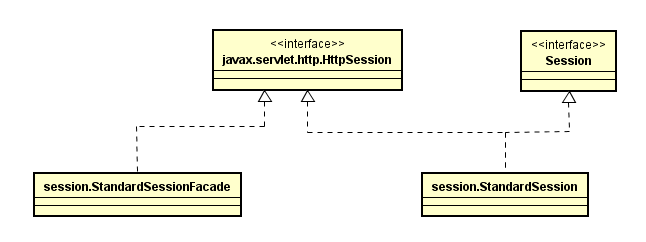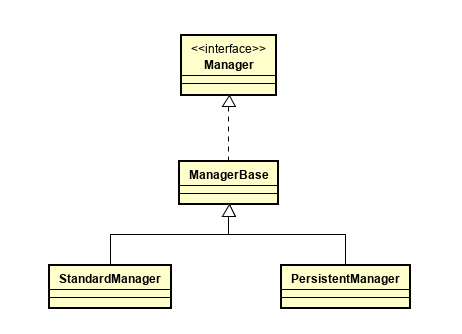小编给大家分享一下Tomcat怎么监控并删除超时Session,希望大家阅读完这篇文章之后都有所收获,下面让我们一起去探讨吧!
前言
偶然发现Tomcat会话时间的半小时,并不是说会话创建后,只有半小时的有效使用时间,而是说会话空闲半小时后,会被删除。索性就翻了一下源码。做了一番整理。
注:空闲时间,指的是同一个会话两次请求之间的间隔时间
Session相关类图

HttpSession就是大家Servlet层可以直接使用的Session.
Session是Tomcat内部使用的接口,可以做一些内部调用
StandardSession是标准的HttpSession实现,同时它也实现了Session接口,用于Tomcat内部管理
StandardSessionFacade,类名已经指明它就是一个“门面类”,它内部会引用一个StandardSession的对象,但对外只提供HttpSession规定的方法。
Manager相关类图

StandardManager与PersitentManager都是Manager的实现,但是它们在存储Session对象的方式上有所不同。
StandarManager
1.Tomcat运行时,把Session存储在内存中
2.Tomcat关闭时(注意是正常的关闭操作,而非突然崩溃),会把Session写入到磁盘中,等到Tomcat重启后再把Session加载进来
PersistentManager
1.总是把Session存储在磁盘中。
Manager与Context的关系
在Tomcat中,一个Context就是部署到Tomcat中的一个应用(Webapp)。每一个Context都有一个单独的Manager对象来管理这个应用的会话信息。

Manager如何存储Session
Manager对象会使用一个Map来存储Session对象
Key => SessionId
Value => Session Object
/**
* The set of currently active Sessions for this Manager, keyed by
* session identifier.
*/
protected Map<String, Session> sessions = new ConcurrentHashMap<>();当一个请求到达Context的时候,如果它带有JSESSIONID的Cookie,Manager就能依此找到关联的Session对象,放入到Request对象中。
Manager的定期检查
Manager接口有一个backgroundProcess()方法,顾名思义就是后台处理。
/**
* This method will be invoked by the context/container on a periodic
* basis and allows the manager to implement
* a method that executes periodic tasks, such as expiring sessions etc.
*/
public void backgroundProcess();注:Container接口也有这个方法,这个方法一般在容器启动(start)的时候,开启一个额外的线程来执行这个backgroundProcess方法。其中Context的这个方法启动后,会执行Loader和Manager的backgroundProcess方法。
我们来看看这个方法都做了些什么?
/**
* {@inheritDoc}
* <p>
* Direct call to {@link #processExpires()}
*/
@Override
public void backgroundProcess() {
count = (count + 1) % processExpiresFrequency;
if (count == 0) //如果达到检查频率则开始检查
processExpires();
}
/**
* Invalidate all sessions that have expired.
*/
public void processExpires() {
long timeNow = System.currentTimeMillis();
Session sessions[] = findSessions(); //获取所有session对象
int expireHere = 0 ; //过期session的数量,不要被这个变量名骗了
if(log.isDebugEnabled())
log.debug("Start expire sessions " + getName() + " at " + timeNow + " sessioncount " + sessions.length);
for (int i = 0; i < sessions.length; i++) {
if (sessions[i]!=null && !sessions[i].isValid()) {
expireHere++;
}
}
long timeEnd = System.currentTimeMillis();
if(log.isDebugEnabled()) //打印记录
log.debug("End expire sessions " + getName() + " processingTime " + (timeEnd - timeNow) + " expired sessions: " + expireHere);
processingTime += ( timeEnd - timeNow );
}很多人看到这里,可能会有跟我一样的疑惑,即这里面根本就没有使Session过期失效的操作,好像只做了状态检查。不过后来看到了Session的isValid方法的实现就都明白了。
/**
* Return the <code>isValid</code> flag for this session.
*/
@Override
public boolean isValid() {
if (!this.isValid) {
return false;
}
if (this.expiring) {
return true;
}
if (ACTIVITY_CHECK && accessCount.get() > 0) {
return true;
}
//关键所在
//如果有设置最大空闲时间
//就获取此Session的空闲时间进行判断
//如果已超时,则执行expire操作
if (maxInactiveInterval > 0) {
int timeIdle = (int) (getIdleTimeInternal() / 1000L);
if (timeIdle >= maxInactiveInterval) {
expire(true);
}
}
return this.isValid;
}看完了这篇文章,相信你对“Tomcat怎么监控并删除超时Session”有了一定的了解,如果想了解更多相关知识,欢迎关注亿速云行业资讯频道,感谢各位的阅读!
亿速云「云服务器」,即开即用、新一代英特尔至强铂金CPU、三副本存储NVMe SSD云盘,价格低至29元/月。点击查看>>
免责声明:本站发布的内容(图片、视频和文字)以原创、转载和分享为主,文章观点不代表本网站立场,如果涉及侵权请联系站长邮箱:is@yisu.com进行举报,并提供相关证据,一经查实,将立刻删除涉嫌侵权内容。